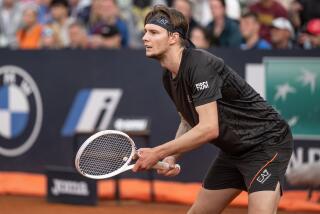Breaks Weren’t Made for No. 1 Woman
- Share via
Justine Henin-Hardenne of Belgium skipped the Pacific Life Open at Indian Wells last year and there was no noticeable outcry from the media, sponsors or spectators. Her absence fell well under the radar.
That’s life at No. 4 in the world.
At No. 1? Any mistake, any misstep and the player will be aired out by any or all of those groups. Last week’s report that Henin-Hardenne was missing the NASDAQ-100 tournament starting Wednesday in Miami fell into that category.
In fact, that was not news. As far back as January, it was known that Henin-Hardenne would not be playing at Miami. The WTA Tour had that information in its weekly release on Feb. 23.
Lindsay Davenport also is skipping that tournament, but she seemed to escape serious scrutiny. Remember, life is different at No. 4.
You can make the same arguments about Henin-Hardenne that were directed at Venus and Serena Williams in the last year, that she’s not properly supporting the tour from her influential position of No. 1 and holder of four titles in 2004. But the system allows her to skip Miami, which is viewed in some quarters as the next-most important tournament after the four Grand Slams.
Players have long been criticized for pulling out of events. Even Wimbledon champion Maud Watson must have pulled out of some tournament at the last minute in 1886 because of tendinitis. At Indian Wells, though, the system itself became a topic of discussion. Maybe it was because the top four players would be missing Miami or because the desultory Conchita Martinez-Anastasia Myskina match at Indian Wells was a quarterfinal in a Tier I tournament.
In any event, ideas were tossed around. One would tie mandatory minimums to entrance in Grand Slam events. For instance, it would take a minimum of 14 WTA tournaments played in one year to be eligible for the Australian Open, the French Open, Wimbledon and the U.S. Open the next year. The breakdown could be eight Tier I events and six in Tier II, or nine and five.
The men are required to play the Masters Series events. In a perfect, injury-free world, they all would. It doesn’t happen. Andre Agassi missed six last year, and Lleyton Hewitt of Australia skipped four.
But the men aren’t the ones struggling with a shortfall of stars, and at Indian Wells, the ATP was missing only one top player, Juan Carlos Ferrero of Spain, who was out with chickenpox.
Now, Grand Slam eligibility isn’t tied to mandatory minimums.
Women’s tennis is run by the WTA; men’s tennis, by the ATP; and the Slams are controlled by the International Tennis Federation (ITF).
Pulling these groups together and getting them in the same room can be hard enough on routine matters. On ground-breaking reform ... ?
It always comes back to the schedule, and pleas by the players for a shorter season. You can have mandatory requirements, but they are meaningless if someone is injured because of overplaying. The injuries and ailments on the WTA Tour have been staggering this year.
“That’s our biggest problem -- three out of the top 10 are healthy,” Martina Navratilova said last week. “Everybody else is laid up. That’s never happened before. That’s our biggest problem. Two of the biggest stars -- Venus hasn’t done anything, and Serena hasn’t played in eight months.
“That’s our problem. You take away seven of the top 10 men’s players and they’re going to have problems. We’re just in short supply right now. The top 10 is depleted. This is a coincidence? I just played doubles last year, and it was rough for me to get going into the next year again. I didn’t have time to decompress.”
Navratilova talked about the distractions that exist for the current stars on the tour, the magnetic pull of Hollywood.
“Most of the top players, they all want to get into acting,” she said. “[Anna] Kournikova. Monica [Seles], that was [once] her goal. No, we were tennis players. Tennis is not a gateway to acting.
“But Venus took it to another plane with design, which is fine, but we’ve been talking about this for a couple of years now. You have to commit to the sport. You can’t do a little bit of this and a little bit of that. You can’t do a dual career, and excel in both of them.”
More to Read
Go beyond the scoreboard
Get the latest on L.A.'s teams in the daily Sports Report newsletter.
You may occasionally receive promotional content from the Los Angeles Times.











